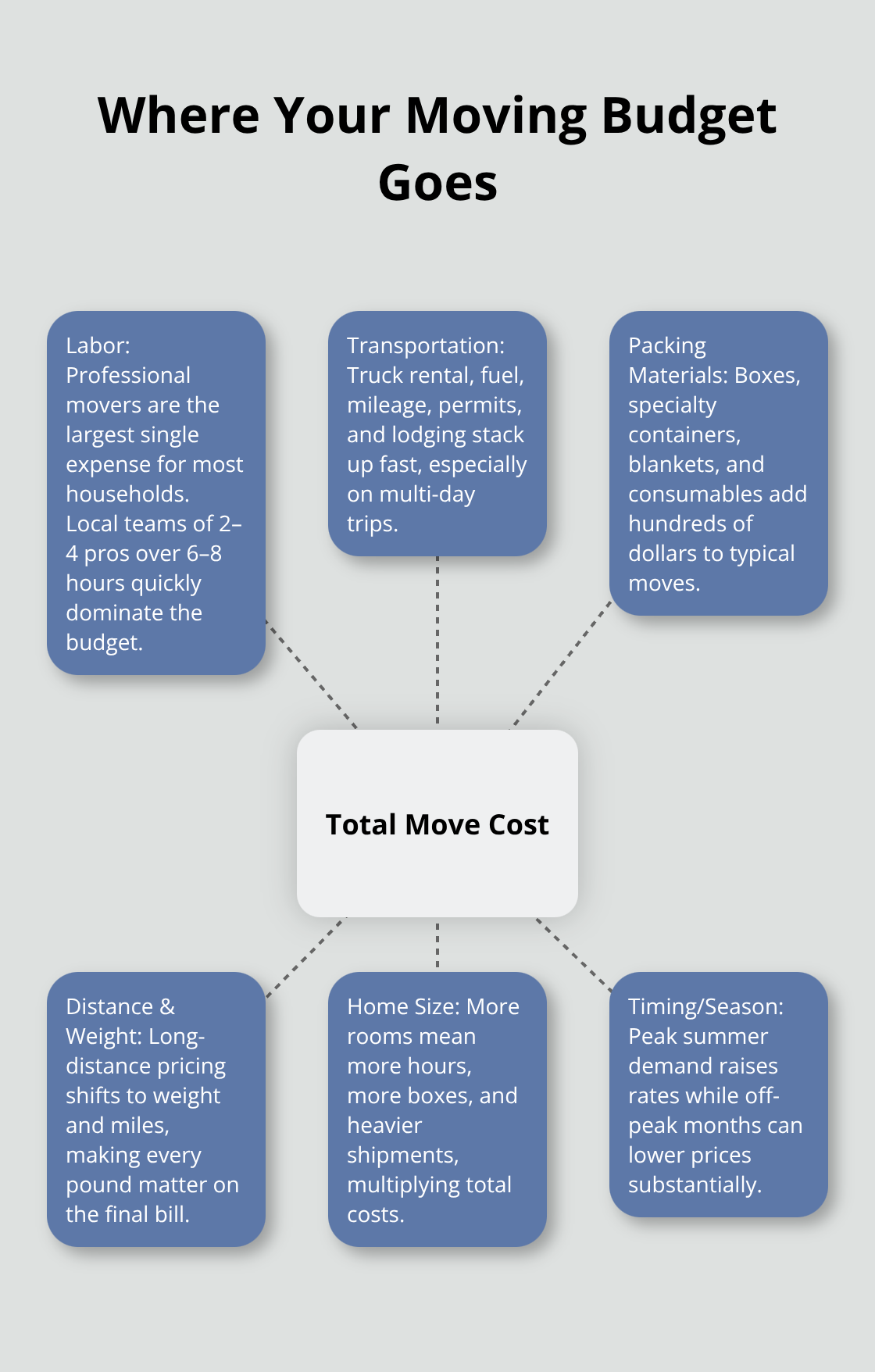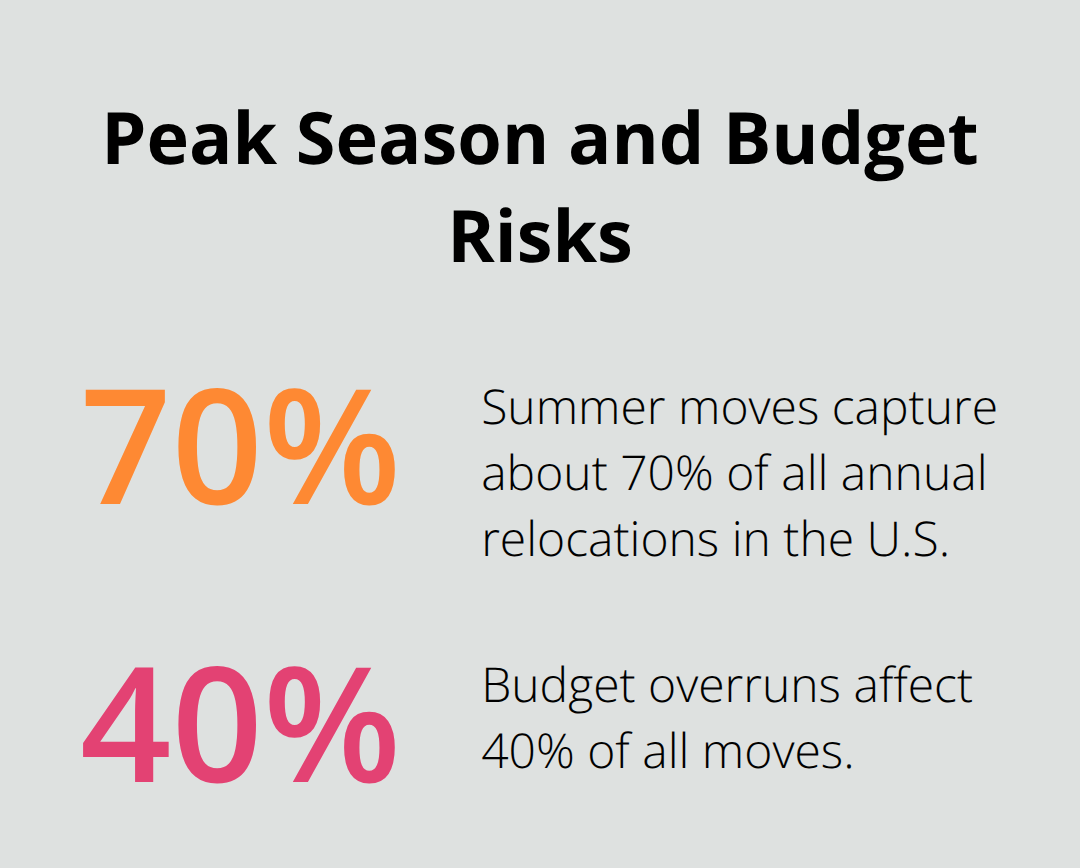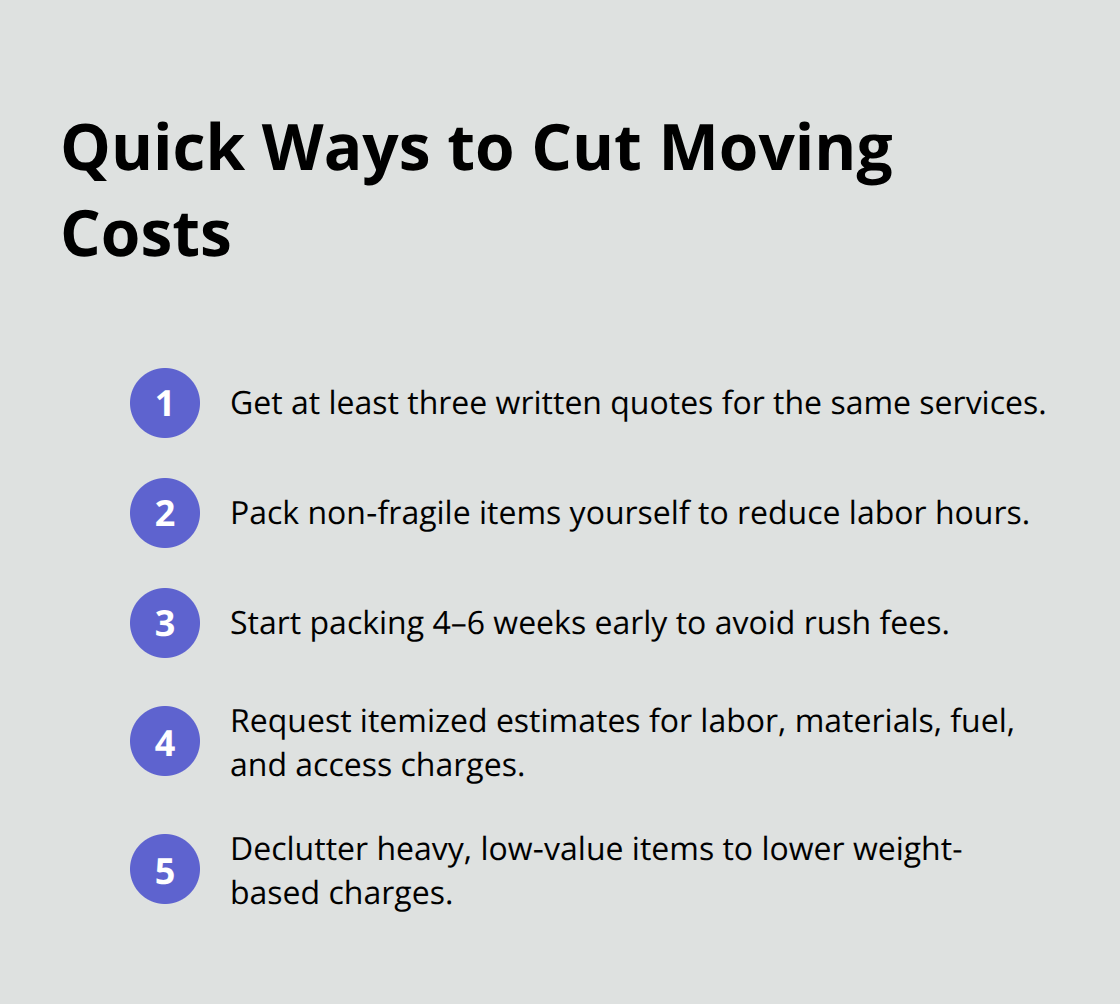Moving house costs vary dramatically based on dozens of factors that most people don’t consider upfront. The approximate cost of moving house ranges from $800 for local moves to over $5,000 for cross-country relocations.
We at Southbay Moving Systems see families shocked by unexpected expenses that can double their initial budget. Understanding these costs beforehand helps you plan better and avoid financial surprises.
Where Does Your Moving Money Actually Go?
Professional Moving Labor Dominates Your Budget
Professional movers consume a significant portion of your total budget, making labor your largest expense. Local moves cost $38 to $75 per mover per hour according to industry data, with most teams including 2-4 professionals. A standard 3-bedroom home needs 6-8 hours of work, which translates to $456-$2,400 in labor costs alone.

Long-distance moves work differently. Companies charge based on weight and distance rather than hourly rates. With long-distance moving companies charging by weight, prices can range from $2,509 to $11,641, depending on the size of the move, with labor costs representing the majority of this expense.
Packing Materials Create Hidden Expenses
Packing supplies cost between $100-$300 for an average household, though this figure climbs rapidly for larger homes. Cardboard boxes average $2 each, and most moves require 20-40 boxes. Specialty items demand expensive protection that many homeowners overlook.
Piano blankets cost $30-$50 each, while wardrobe boxes run $8-$12 per unit. Bubble wrap, tape, and paper expenses accumulate quickly, especially when you move fragile electronics or artwork. These costs surprise many families who focus only on the major expenses.
Transportation Costs Extend Beyond Gas
Fuel expenses reach far beyond the truck’s gas tank. Local truck rentals charge $29.95 per day plus $1.29 per mile, while long-distance rentals can reach $3,000-$4,000 (including fuel). Additional transportation expenses include multiple trips for oversized items, parking permits in urban areas that average $50-$200, and potential hotel stays during multi-day moves.
Weight-based pricing for long-distance moves means every pound costs money. This makes decluttering a financial necessity rather than convenience. These transportation realities directly connect to the factors that can dramatically increase or decrease your total budget.
What Drives Your Moving Costs Higher
Distance Changes Everything About Pricing
Distance creates the biggest expense difference in your moving costs more dramatically than any other single factor. Local moves are typically charged by the hour, while long-distance moves are calculated based on the weight of your belongings and the distance. Cross-country moves jump to $2,509-$11,641 based on your household size.
Moving from California to Texas costs 300% more than moving across town, even with identical belongings. Interstate moves face additional complications including state regulations, multiple-day transport, and mandatory insurance requirements that local moves avoid completely. The pricing structure shift from hourly to weight-based calculations creates dramatic cost differences that catch many homeowners off guard.
Home Size Multiplies Labor and Material Needs
Your home’s size directly correlates with moving expenses through weight calculations and labor hours. Studio apartments average $501-$985 for local moves, while 4-5 bedroom houses range from $1,941-$2,988. Long-distance moves calculate costs per pound, with larger homes weighing 12,000-16,000 pounds compared to apartments at 2,000-4,000 pounds.
Each additional room adds 2-3 hours of packing time and requires 8-12 extra boxes. Specialty items like pianos, hot tubs, or workshop equipment can add $500-$2,000 in handling fees regardless of your home’s base size. The weight factor becomes particularly expensive when you transport heavy furniture or appliances across long distances.
Peak Season Pricing Hits Your Wallet Hard
Summer moving season from Memorial Day through Labor Day captures around 70% of all annual moves, which drives prices up 25-40% during peak demand. Mid-month and mid-week moves cost significantly less than weekend and month-end relocations when apartment leases typically expire.
October through April offers the lowest rates, with some companies reducing prices by 20-30% to maintain business during slow periods. Holiday weekends and the first week of each month represent the most expensive times to move (often doubling standard rates). Smart timing decisions can save you hundreds or thousands of dollars, which makes flexibility your most powerful tool for controlling these escalating costs.

How to Cut Your Moving Costs in Half
Compare Multiple Moving Company Quotes
Three moving company quotes save you an average of $800-$1,500 on your total move cost. The American Moving & Storage Association recommends this practice because companies price identical services differently. Price differences of 40-50% exist between the highest and lowest bids for the same household move.
Moving costs are calculated based on distance, home size, shipment volume/weight, and the required labor and services. Local moves are more affordable. Request written estimates that break down all fees (labor, materials, fuel, and potential additional charges for stairs or long carries). Avoid companies that provide estimates over the phone or demand large deposits upfront, as these practices often indicate unreliable service.
Pack Your Own Items to Save Labor Costs
Professional packers charge $25-$40 per hour per packer, which adds $500-$1,200 to most household moves. Pack non-fragile items yourself and eliminate this expense entirely. Start this process 4-6 weeks before your move date, with books, clothes, and decorative items first.
Leave fragile electronics, artwork, and glassware for professional packers if your budget allows. Damage claims on self-packed items face more restrictions. Use free boxes from liquor stores, grocery stores, and online marketplaces instead of new ones. This strategy alone reduces material costs by 60-70% compared to retail box purchases.

Declutter Strategically to Reduce Weight Charges
Decluttering before your move cuts costs more effectively than any other single action for long-distance relocations. Weight-based charges range from $0.50-$2.00 per pound depending on distance. Sell or donate 1,000 pounds of items and save $500-$2,000 on cross-country moves.
Focus on heavy items with low replacement value like old appliances, outdated electronics, and rarely-used furniture. Decluttering makes moving easier for everyone and less costly, too. It is also helpful for those who want to live more simply in their current home.
Final Thoughts
The approximate cost of moving house ranges from $800 for local relocations to over $5,000 for cross-country moves, with most families spending between $1,000-$5,000 total. Professional labor represents your largest expense, followed by transportation and packing materials that add hundreds more to your budget. Accurate estimates from multiple companies prevent budget overruns that affect 40% of all moves.
Written quotes protect you from surprise fees and help you compare services properly. Companies that provide phone estimates or demand large deposits often hide additional charges. Plan 6-8 weeks ahead to declutter, gather free packing supplies, and schedule during off-peak periods when rates drop 20-30% (summer moves cost significantly more due to demand).
We at Southbay Moving Systems provide transparent estimates and personalized service for Central California relocations. Our detailed quotes eliminate hidden fees and help you understand exactly what your move will cost. Smart planning and professional guidance transform potentially overwhelming moves into manageable experiences within your budget.




